Canada Electric Vehicle Battery Separator Market Size
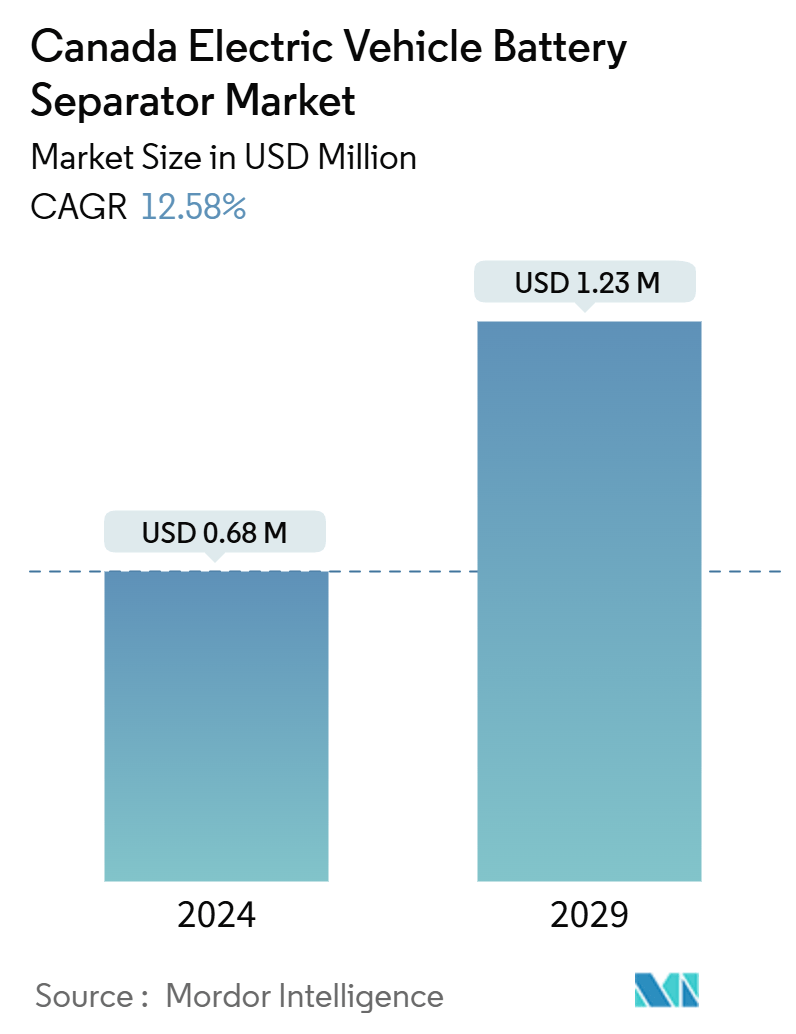
| Study Period | 2019 - 2029 |
| Base Year For Estimation | 2023 |
| Market Size (2024) | USD 0.68 Million |
| Market Size (2029) | USD 1.23 Million |
| CAGR (2024 - 2029) | 12.58 % |
| Market Concentration | High |
Major Players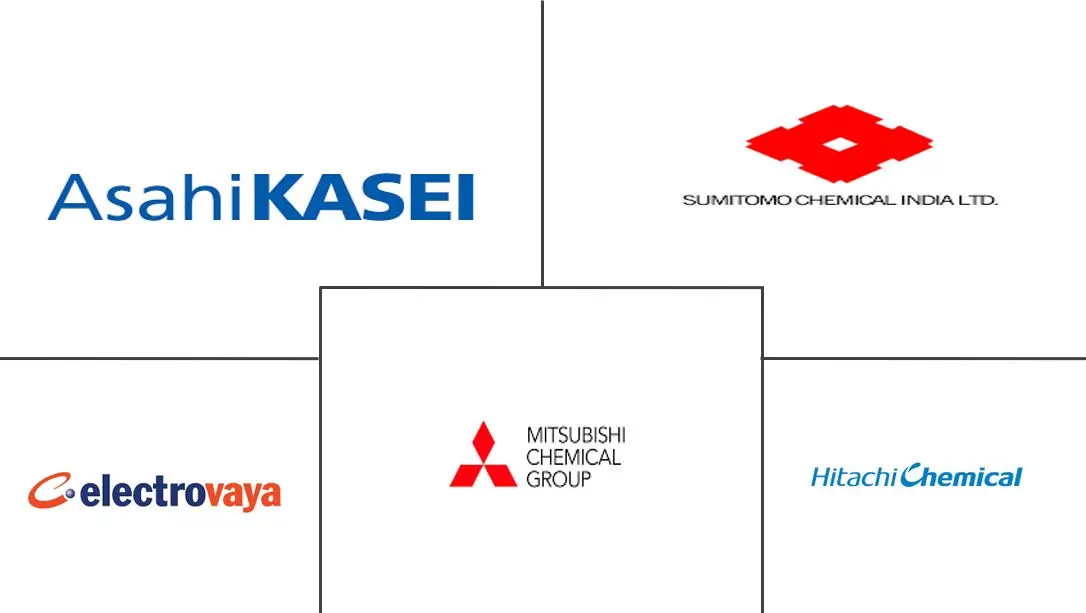
*Disclaimer: Major Players sorted in no particular order |
Canada Electric Vehicle Battery Separator Market Analysis
The Canada Electric Vehicle Battery Separator Market size is estimated at USD 0.68 million in 2024, and is expected to reach USD 1.23 million by 2029, at a CAGR of 12.58% during the forecast period (2024-2029).
- Over the medium period, the growing adoption of electric vehicles and the decreasing price of lithium-ion batteries is expected to drive the market in the forecast period.
- On the other hand, the supply chain gap in battery materials created by the monopolies of some countries, such as ingredient shortages or distribution bottlenecks, is expected to restrain market growth in the future.
- Nevertheless, the increasing research and development of other battery chemistries like solid-state batteries, advanced lithium-ion chemistry, Sodium-ion batteries, etc, are expected to create an opportunity for the market in the future.
Canada Electric Vehicle Battery Separator Market Trends
Growing Adoption of Electric Vehicles Drives the Market
- Canada's shift towards clean energy and electric vehicles (EVs) is propelling the growth of the EV battery separator market. Companies are increasingly honing in on this segment, spurred by a surge in consumer interest. This enthusiasm is predominantly driven by a heightened awareness of environmental issues, the financial advantages of owning an EV, and significant technological advancements in the EV sector.
- Moreover, Canada has witnessed a pronounced increase in EV sales in recent years. The International Energy Agency (IEA) highlighted that in 2023, Canada recorded sales of 0.171 million electric vehicles. This marks a substantial 48.69% increase from 2022 and is 2.4 times the sales figures from 2019. With the Canadian government's recent initiatives amplifying this momentum, EV sales are set to climb further, intensifying the demand for EV battery separators.
- In addition, the Canadian government has rolled out a suite of incentives and subsidies to champion the adoption of electric vehicles. These initiatives range from tax breaks and grants for electric vehicle purchases to bolstered investments in charging infrastructure. Such measures align seamlessly with the government's overarching goals of curbing carbon emissions and meeting climate targets.
- As an illustration, in 2023, the federal government allocated up to USD 5,000 for the purchase or lease of zero-emission vehicles (ZEVs). This program has already seen participation from over 180,000 individuals and businesses. On top of that, provinces like Quebec and British Columbia have established sales targets for ZEVs, further accelerating the transition to electric and hybrid vehicles. These concerted efforts are set to amplify the demand for passenger cars in the region, subsequently driving up the need for battery separators in the forecast period.
- Furthermore, Canada's automotive sector is witnessing a surge in investments directed towards EV battery production. As Canadian firms delve deeper into EV manufacturing, there's been a notable uptick in the demand for premium battery components, especially separators. This trend highlights the industry's commitment to both innovation and sustainability.
- For instance, in April 2024, Honda Motor announced a monumental investment of CAD 15 billion (USD 11 billion) to set up new EV and battery production facilities in Ontario. This move, which bolsters Honda's existing operations, is a strategic play to cater to the burgeoning EV demand in North America. It also underscores Honda's intent to solidify its presence in the electric vehicle domain. Such initiatives are broadening the electric vehicle offerings in the region, thereby fueling the growth of the EV battery separator market in the foreseeable future.
- Consequently, with these initiatives and projects, the demand for EVs is anticipated to surge, leading to a significant uptick in the need for EV battery separators in the coming years.
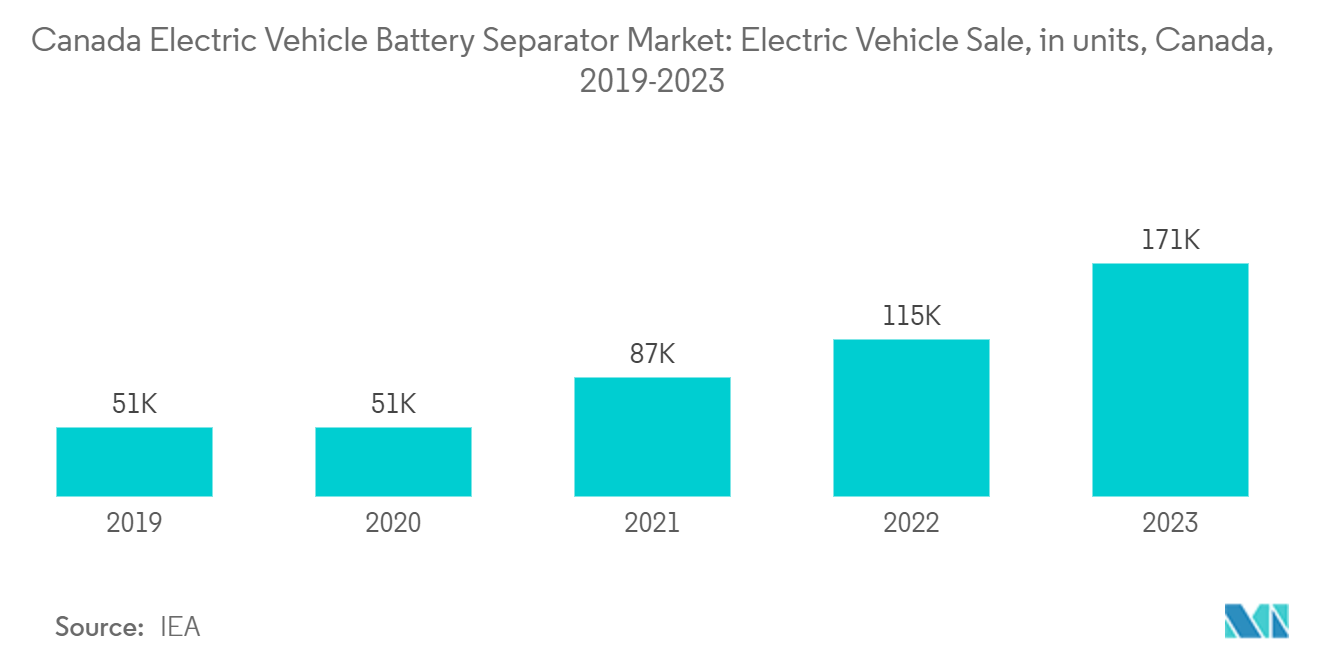
Lithium-Ion Battery Type Dominate the Market
- The lithium-ion (Li-ion) battery type is pivotal in driving the growth of the EV battery separator market, thus influencing the electric vehicle (EV) industry's trajectory. Li-ion batteries, known for their high energy density, extended cycle life, and minimal self-discharge rate, have emerged as the preferred choice for electric vehicles. This dominant preference for Li-ion batteries in the EV sector subsequently fuels the demand for specialized separators designed for these batteries.
- Key market players are boosting their R&D investments and production efforts, heightening competition and pushing prices down. For instance, Bloomberg NEF highlights that while average battery pack prices for EVs and battery energy storage systems (BESS) have generally risen, 2023 witnessed a significant drop, with prices falling to USD 139/kWh — marking a 13% decrease. Projections suggest this downward trend will persist, with prices anticipated to reach USD 113/kWh by 2025 and plummet further to USD 80/kWh by 2030, driven by relentless technological and manufacturing advancements.
- Additionally, Canada's lithium-ion battery industry is booming, largely driven by the escalating demand for electric vehicles (EVs) and energy storage systems. Battery separators are vital for the safety and efficiency of lithium-ion batteries in EVs. These separators prevent direct contact between positive and negative electrodes while allowing ions to pass. As a result, the demand for lithium-ion batteries in the region has consistently risen, leading major companies to establish multiple battery plants to enhance production capacities.
- For example, in October 2023, Volkswagen unveiled plans for a new battery manufacturing facility, bolstered by a substantial investment of USD 7 billion. Located in an industrial park, the expansive plant will span approximately 370 acres. This strategic move highlights Volkswagen's commitment to ramping up electric vehicle production and strengthening its presence in both global and local markets. Such initiatives are set to elevate lithium-ion battery production in the coming years, subsequently increasing the demand for battery separators in the region.
- Furthermore, innovations in lithium-ion battery technology—such as heightened energy density, improved safety measures, and enhanced charging efficiency—are spurring the creation of new separator materials. These separators, crafted to endure the stringent energy and thermal requirements of Li-ion batteries, emphasize safety and reliability. This focus not only drives innovation but also amplifies demand in the separator market.
- For instance, in February 2024, Dalhousie, in collaboration with Tesla, is inaugurating a new battery R&D center and rolling out a Master's program in battery technology for 2025. The newly launched USD 13.5-million Canadian Battery Innovation Centre, paired with the graduate program, seeks to meet Canada's rising demand for EV battery expertise. Such advancements are likely to elevate the demand for sophisticated lithium battery separators in the region in the coming years.
- Consequently, these initiatives are poised to bolster lithium-ion battery production and significantly amplify the capacity of EV battery separators during the forecast period.
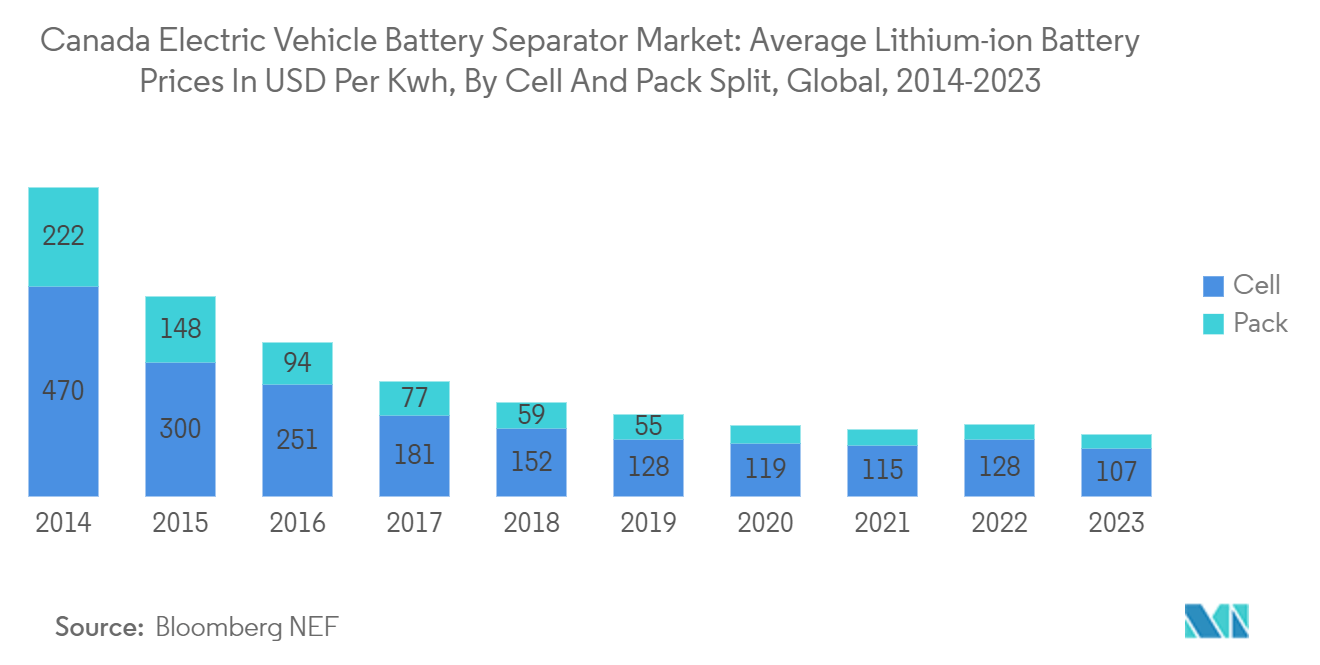
Canada Electric Vehicle Battery Separator Industry Overview
Canada's electric vehicle battery separator market is semi-consolidated. Some key players (not in particular order) are Mitsubishi Chemical Group Corporation, Hitachi Chemical Company Ltd, Sumitomo Chemical Co. Ltd, Electrovaya, Asahi Kasei Corporation, among others.
Canada Electric Vehicle Battery Separator Market Leaders
-
Hitachi Chemical Company Ltd
-
Mitsubishi Chemical Group Corporation
-
Sumitomo Chemical Co. Ltd
-
Electrovaya
-
Asahi Kasei Corporation
*Disclaimer: Major Players sorted in no particular order
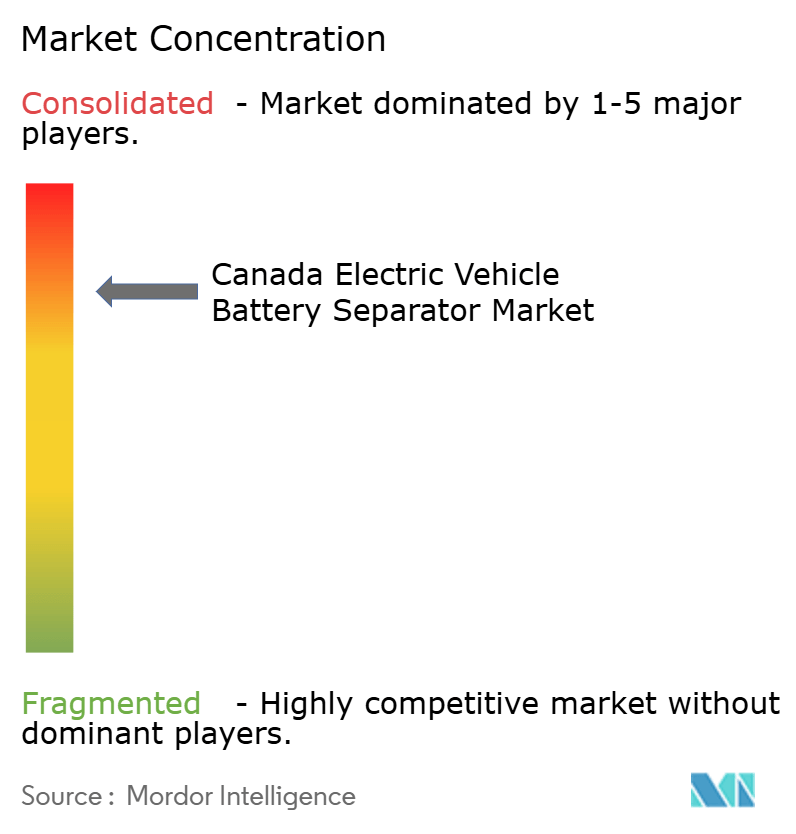
Canada Electric Vehicle Battery Separator Market News
- March 2024: Asahi Kasei announced a significant investment to establish Canada's inaugural industrial-scale electric vehicle (EV) battery separator plant in Port Colborne, Ontario. This move strengthens the province's EV battery supply chain and solidifies its position as a leader in the global EV transition.
- January 2024: SK ie technology, a Korean manufacturer of battery separators, is contemplating the establishment of a new plant in Canada, with Ontario and Quebec as potential locations. The company has indicated that the decision to set up a separator factory in North America is being internally evaluated, with an announcement expected in 2024.
Canada Electric Vehicle Battery Separator Market Report - Table of Contents
1. INTRODUCTION
1.1 Scope of the Study
1.2 Market Definition
1.3 Study Assumptions
2. EXECUTIVE SUMMARY
3. RESEARCH METHODOLOGY
4. MARKET OVERVIEW
4.1 Introduction
4.2 Market Size and Demand Forecast in USD, till 2029
4.3 Recent Trends and Developments
4.4 Government Policies and Regulations
4.5 Market Dynamics
4.5.1 Drivers
4.5.1.1 Growing Adoption of Electric Vehicles
4.5.1.2 Decline in cost of battery raw materials
4.5.2 Restraints
4.5.2.1 The Supply Chain Gap
4.6 Supply Chain Analysis
4.7 PESTLE ANALYSIS
4.8 Investment Analysis
5. MARKET SEGMENTATION
5.1 Battery
5.1.1 Lithium-ion
5.1.2 Lead-Acid
5.1.3 Others
5.2 Material Type
5.2.1 Polypropylene
5.2.2 Polyethylene
5.2.3 Other Material Types
6. COMPETITIVE LANDSCAPE
6.1 Mergers and Acquisitions, Joint Ventures, Collaborations, and Agreements
6.2 Strategies Adopted by Leading Players
6.3 Company Profiles
6.3.1 Mitsubishi Chemical Group Corporation
6.3.2 Hitachi Chemical Company Ltd
6.3.3 Asahi Kasei Corporation
6.3.4 Sumitomo Chemical Co. Ltd
6.3.5 Electrovaya
6.3.6 3M Canada
- *List Not Exhaustive
6.4 List of Other Prominent Companies
6.5 Market Ranking Analysis
7. MARKET OPPORTUNITIES AND FUTURE TRENDS
7.1 Increasing Research and Development of Other Battery Chemistries
Canada Electric Vehicle Battery Separator Industry Segmentation
An electric vehicle battery separator is a crucial element physically separating the positive and negative electrodes within the battery cell. It prevents short circuits while allowing ions to pass through, facilitating the flow of current necessary for powering the vehicle.
Canada's electric vehicle battery separator market is segmented by battery type and material type. By battery type, the market is segmented into Lithium-Ion Battery, Lead-Acid Battery, and Others. By material type, the market is segmented into polypropylene, Polyethylene, and Other Material Types. The Report Offers the Market Size and Forecasts in Revenue (USD) for all the Above.
| Battery | |
| Lithium-ion | |
| Lead-Acid | |
| Others |
| Material Type | |
| Polypropylene | |
| Polyethylene | |
| Other Material Types |
Canada Electric Vehicle Battery Separator Market Research Faqs
How big is the Canada Electric Vehicle Battery Separator Market?
The Canada Electric Vehicle Battery Separator Market size is expected to reach USD 0.68 million in 2024 and grow at a CAGR of 12.58% to reach USD 1.23 million by 2029.
What is the current Canada Electric Vehicle Battery Separator Market size?
In 2024, the Canada Electric Vehicle Battery Separator Market size is expected to reach USD 0.68 million.
Who are the key players in Canada Electric Vehicle Battery Separator Market?
Hitachi Chemical Company Ltd, Mitsubishi Chemical Group Corporation, Sumitomo Chemical Co. Ltd, Electrovaya and Asahi Kasei Corporation are the major companies operating in the Canada Electric Vehicle Battery Separator Market.
What years does this Canada Electric Vehicle Battery Separator Market cover, and what was the market size in 2023?
In 2023, the Canada Electric Vehicle Battery Separator Market size was estimated at USD 0.59 million. The report covers the Canada Electric Vehicle Battery Separator Market historical market size for years: 2019, 2020, 2021, 2022 and 2023. The report also forecasts the Canada Electric Vehicle Battery Separator Market size for years: 2024, 2025, 2026, 2027, 2028 and 2029.
Canada Electric Vehicle Battery Separator Industry Report
Statistics for the 2024 Canada Electric Vehicle Battery Separator market share, size and revenue growth rate, created by Mordor Intelligence™ Industry Reports. Canada Electric Vehicle Battery Separator analysis includes a market forecast outlook for 2024 to 2029 and historical overview. Get a sample of this industry analysis as a free report PDF download.

